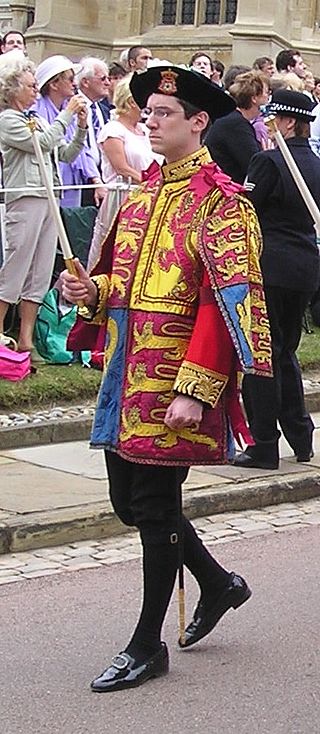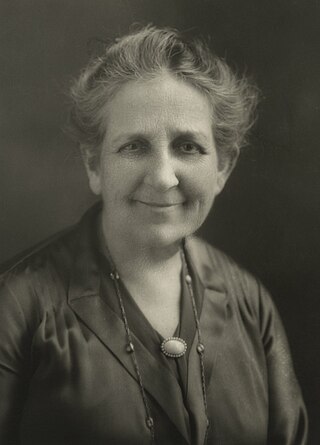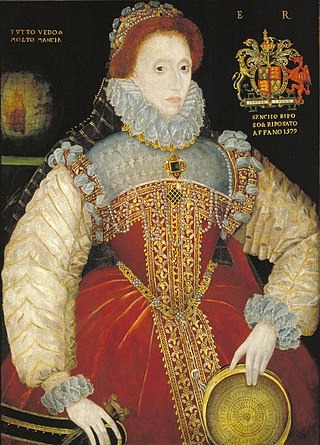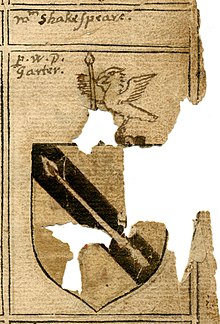
The Folger Shakespeare Library is an independent research library on Capitol Hill in Washington, D.C., United States. It has the world's largest collection of the printed works of William Shakespeare, and is a primary repository for rare materials from the early modern period (1500–1750) in Britain and Europe. The library was established by Henry Clay Folger in association with his wife, Emily Jordan Folger. It opened in 1932, two years after his death.

William Henry Ireland (1775–1835) was an English forger of would-be Shakespearean documents and plays. He is less well known as a poet, writer of gothic novels and histories. Although he was apparently christened William-Henry, he was known as Samuel through much of his life, and many sources list his name as Samuel William Henry Ireland.

Mr. William Shakespeare's Comedies, Histories, & Tragedies is a collection of plays by William Shakespeare, commonly referred to by modern scholars as the First Folio, published in 1623, about seven years after Shakespeare's death. It is considered one of the most influential books ever published.
The Shakespeare Theatre Company is a regional theatre company located in Washington, D.C. The theatre company focuses primarily on plays from the Shakespeare canon, but its seasons include works by other classic playwrights such as Euripides, Ibsen, Wilde, Shaw, Schiller, Coward and Tennessee Williams. The company manages and performs in two spaces: The Michael R. Klein Theatre and Sidney Harman Hall. In cooperation with George Washington University, they run the STC Academy.

Michael Peter Desmond O'Donoghue is a British officer of arms who currently serves as York Herald of Arms in Ordinary at the College of Arms in London. He was appointed to the office on 31 May 2012, having served as Bluemantle Pursuivant from 2005.
Michael Kahn CBE is an American theater director and drama educator. He was the artistic director of the Shakespeare Theatre Company in Washington, D.C. from 1986 until his retirement in 2019. He held the position of Richard Rodgers Director of the Drama Division of the Juilliard School from 1992 to 2006.

Joseph Quincy Adams Jr. was a prominent Shakespeare scholar and the first officially appointed director of the Folger Shakespeare Library in Washington, D.C.

Emily Jordan Folger, was the wife of Henry Clay Folger and the co-founder of the Folger Shakespeare Library. During her husband's lifetime, she assisted him in building the world's largest collection of Shakespeare materials. After his death in 1930, she funded the completion of the Folger Shakespeare Library to house the collection, remaining involved with its administration until her death in 1936.

The Ashbourne portrait is one of several portraits that have been falsely identified as portrayals of William Shakespeare. At least 60 such works had been offered for sale to the National Portrait Gallery in the 19th century within the first forty years of its existence; the Ashbourne portrait was one of these. The portrait is now a part of the collection of the Folger Shakespeare Library in Washington, DC.
Sir Thomas Cawarden of Bletchingley, Nonsuch Park and East Horsley (Surrey) was Master of the Revels to Henry VIII, Edward VI, and Mary I.

William Shakespeare's handwriting is known from six surviving signatures, all of which appear on legal documents. It is believed by many scholars that the three pages of the handwritten manuscript of the play Sir Thomas More are also in William Shakespeare's handwriting. This is based on many studies by a number of scholars that considered handwriting, spelling, vocabulary, literary aspects, and more.

Sir William More, of Loseley, Surrey, was the son of Sir Christopher More. The great house at Loseley Park was built for him, which is still the residence of the More Molyneux family. Of Protestant sympathies, as Sheriff and Vice-Admiral of Surrey he was actively involved in local administration of the county of Surrey and in the enforcement of the Elizabethan religious settlement, and was a member of every Parliament during the reign of Queen Elizabeth I. He was the owner of property in the Blackfriars in which the first and second Blackfriars theatres were erected. He has been described as "the perfect Elizabethan country gentleman" on account of his impeccable character and his assiduity and efficiency of service.
Jeremy Frank Maule was a British scholar specialising in English literature and the history of the English language. He had an especial interest in seventeenth-century poetry and in manuscripts from this period.

The Plimpton Sieve Portrait of Queen Elizabeth I is an oil painting by English painter George Gower dated 1579, and now in the collection of the Folger Shakespeare Library in Washington, D.C. It is one of three near-identical portraits of Elizabeth I by Gower that represent the queen holding a symbolic sieve. It was acquired by George Arthur Plimpton in 1930, hence the name. His son, Francis T. P. Plimpton, willed it to the Folger.

The Trevelyon Miscellany of 1608, compiled by Thomas Trevelyon in London, England in 1608, is an illustrated manuscript miscellany containing handwritten notes and drawings on historical, religious, social and practical themes, adapted from a variety of sources, including the Bible and ancient and contemporary English writers. According to Dr. Heather Wolfe, Curator of Manuscripts and Archivist at the Folger Shakespeare Library, "the primary purposes of the Trevelyon miscellany ... are didactic and mnemonic. The extracts and examples from secular, allegorical, and Protestant texts are an enduring monument for improving one's moral conduct in this life and preparing for the next."

Thomas Trevelyon lived in England and is believed to have been an embroidery pattern drawer. He is long known for having compiled two large manuscript miscellanies, the Miscellany of 1608 now in the collection of the Folger Shakespeare Library, and the Great Book of 1616 now in the library at Wormsley Park. A third miscellany, in the collection of University College London was identified as being in his hand in 2012, and dates to circa 1603.

John Clement Fitzpatrick was an archivist and an early American historian, widely regarded as an authority on George Washington. He was noted for his groundbreaking work editing Washington's diaries and many letters and documents. Appointed by the George Washington Bicentennial Commission he prevailed over the editorship in his acclaimed 39 volume work, The Writings of George Washington, published between 1931 and 1944. His involvement during this prolonged effort set many of the standards for the management of manuscripts in the Library of Congress. Fitzpatrick died before all the volumes had been published. He belonged to a number of historical societies while also earning honorary degrees from several prominent universities. Fitzpatrick's years of correspondence and other records have provided historians with valuable sources of information on the life of and events surrounding George Washington, and on the history of Washington, D.C. for that era.

Michael Witmore is a Shakespearean, scholar of rhetoric, digital humanist, and director of a library and cultural institution. In 2011, he was appointed the director of the Folger Shakespeare Library in Washington, D.C., where he continues to serve.
Maygene Frost Daniels is an American art historian who was President of the Society of American Archivists. She was the chief archivist at the National Gallery of Art in Washington and has written books on being an archivist and art history.

The Shakespeare coat of arms is an English coat of arms. It was granted to John Shakespeare, a glover from Stratford-upon-Avon, Warwickshire, in 1596, and was used by his son, the playwright William Shakespeare, and other descendants.















